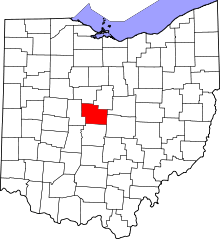Delaware, Ohio
| Delaware | |
|---|---|
| City | |
|
Sandusky and William Streets downtown | |
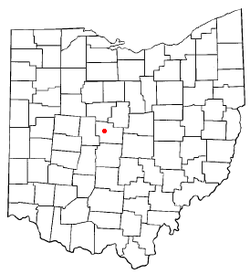 Location of Delaware in Ohio | |
 Location of Delaware in Delaware County | |
| Coordinates: 40°17′56″N 83°4′19″W / 40.29889°N 83.07194°WCoordinates: 40°17′56″N 83°4′19″W / 40.29889°N 83.07194°W | |
| Country | United States |
| State | Ohio |
| County | Delaware |
| Founded | 1808 |
| Area[1] | |
| • Total | 19.07 sq mi (49.39 km2) |
| • Land | 18.95 sq mi (49.08 km2) |
| • Water | 0.12 sq mi (0.31 km2) |
| Population (2010)[2] | |
| • Total | 34,753 |
| • Estimate (2012[3]) | 35,925 |
| • Density | 1,833.9/sq mi (708.1/km2) |
| Time zone | Eastern (EST) (UTC-5) |
| • Summer (DST) | EDT (UTC-4) |
| ZIP codes | 43015 |
| Website | City of Delaware Ohio |
Delaware is a city in and the county seat of Delaware County, Ohio, United States.[4] Delaware was founded in 1808 and was incorporated in 1816. It is located near the center of Ohio, is about 30 miles (48 km) north of Columbus, and is part of the Columbus, Ohio Metropolitan Area. The population was 34,753 at the 2010 census, while the Columbus-Marion-Chillicothe, OH Combined Statistical Area has 2,002,604 people.[5]
History
While the city and county of Delaware are named for the Delaware tribe,[6] the city of Delaware itself was founded on a Mingo village called Pluggy's Town. The first recorded settler was Joseph Barber in 1807. Shortly after other men started settling in the area (according to the Delaware Historical Society)- Moses Byxbe, William Little, Solomon Smith, and Elder Jacob Drake, Thomas Butler, and Ira Carpenter began building in the area. In 1808, Moses Byxbe built the first framed house on William Street.[7] On March 11, 1808, a plan of the city was filed, marking the official founding of the town. Byxbe and the others planned the city to be originally on the east bank of the river, but was switched to the west bank only a few days after the first plan was filed.
Even though Delaware was still a small community, in 1812, when the capital of Ohio was moved from Chillicothe, Delaware and Columbus were both in the running and Delaware lost by a single vote to Columbus.[8] However, following the War of 1812, settlers began arriving in Delaware in greater numbers. Among some of the earliest settlers were the parents of Rutherford B. Hayes, the 19th President of the United States. The Hayes home no longer stands, but a historical marker in front of a BP station marks the location.
In the early days of the town, a sulfur spring was discovered northwest of Joseph Barber's cabin. By 1833, a hotel was built as a health spa near the spring. However, the Mansion House Hotel was a failure, and by 1841, citizens began raising funds to purchase the hotel property with the intent of giving it to the Ohio and North Ohio Methodist Episcopal Conference of the Methodist Church for the purpose of a Methodist college. With that effort, Ohio Wesleyan University was founded in 1844.[9]
Railroads came to the area in April, 1851 as Delaware served as a stop on the Cleveland Columbus and Cincinnati Railroad. Additional rail lines were added to serve Delaware providing access to major cities and markets throughout the country by the late 1890s. At the turn of the century, Delaware could boast of its own electric street railway system. In the early 1930s, electric inter-urban service was provided by the Columbus, Delaware and Marion system.
During the Civil War
During the Civil War, Delaware was the home to two Union training camps. The first on the west side of the river for white recruits of the 96th and 121st Ohio Volunteer Infantry were mustered into service. The second, on the east side of the river was for African-Americans joining the army in Ohio in the 127th Regiment of Ohio Volunteer Infantry - later renamed the 5th Regiment United States Colored Troops.[10]
Geography
Delaware is located at 40°17′56″N 83°4′19″W / 40.29889°N 83.07194°W (40.298898, -83.072007).[11]
The city is located about 24 miles north of Ohio's capital city, Columbus, due north along U.S. Route 23.
According to the United States Census Bureau, the city has a total area of 19.07 square miles (49.39 km2), of which 18.95 square miles (49.08 km2) are land and 0.12 square miles (0.31 km2) is water.[1]
Demographics
| Historical population | |||
|---|---|---|---|
| Census | Pop. | %± | |
| 1810 | 200 | — | |
| 1820 | 369 | 84.5% | |
| 1830 | 527 | 42.8% | |
| 1840 | 898 | 70.4% | |
| 1850 | 2,074 | 131.0% | |
| 1860 | 3,889 | 87.5% | |
| 1870 | 5,641 | 45.1% | |
| 1880 | 6,894 | 22.2% | |
| 1890 | 8,224 | 19.3% | |
| 1900 | 7,940 | −3.5% | |
| 1910 | 9,076 | 14.3% | |
| 1920 | 8,756 | −3.5% | |
| 1930 | 8,675 | −0.9% | |
| 1940 | 8,944 | 3.1% | |
| 1950 | 11,804 | 32.0% | |
| 1960 | 13,282 | 12.5% | |
| 1970 | 15,008 | 13.0% | |
| 1980 | 18,780 | 25.1% | |
| 1990 | 20,030 | 6.7% | |
| 2000 | 25,243 | 26.0% | |
| 2010 | 34,753 | 37.7% | |
| Est. 2015 | 37,995 | [12] | 9.3% |
| Sources:[13][14][15][16] | |||
2010 census
As of the census[2] of 2010, there were 34,753 people, 13,253 households, and 8,579 families residing in the city. The population density was 1,833.9 inhabitants per square mile (708.1/km2). There were 14,192 housing units at an average density of 748.9 per square mile (289.2/km2). The racial makeup of the city was 90.6% White, 4.5% African American, 0.2% Native American, 1.4% Asian, 0.8% from other races, and 2.5% from two or more races. Hispanic or Latino of any race were 2.5% of the population.
There were 13,253 households of which 35.9% had children under the age of 18 living with them, 48.7% were married couples living together, 11.7% had a female householder with no husband present, 4.4% had a male householder with no wife present, and 35.3% were non-families. 28.4% of all households were made up of individuals and 9.4% had someone living alone who was 65 years of age or older. The average household size was 2.47 and the average family size was 3.04.
The median age in the city was 33.2 years. 25.5% of residents were under the age of 18; 11.8% were between the ages of 18 and 24; 30.5% were from 25 to 44; 21.1% were from 45 to 64; and 11.1% were 65 years of age or older. The gender makeup of the city was 48.0% male and 52.0% female.
2000 census
As of the census[15] of 2000, there were 25,243 people, 9,520 households, and 6,359 families residing in the city. The population density was 1,682.9 people per square mile (649.8/km²). There were 10,208 housing units at an average density of 680.5 per square mile (262.8/km²). The racial makeup of the city was 92.8% White, 3.8% African American, 0.19% Native American, 0.84% Asian, 0.10% Pacific Islander, 0.55% from other races, and 1.66% from two or more races. Hispanic or Latino of any race were 1.2% of the population.
There were 9,520 households out of which 34.7% had children under the age of 18 living with them, 52.1% were married couples living together, 11.1% had a female householder with no husband present, and 33.2% were non-families. 26.9% of all households were made up of individuals and 9.1% had someone living alone who was 65 years of age or older. The average household size was 2.45 and the average family size was 2.98.
In the city the population was spread out with 24.7% under the age of 18, 14.5% from 18 to 24, 31.0% from 25 to 44, 18.9% from 45 to 64, and 10.9% who were 65 years of age or older. The median age was 32 years. For every 100 females there were 91.5 males. For every 100 females age 18 and over, there were 87.5 males.
The median income for a household in the city was $46,030, and the median income for a family was $54,463. Males had a median income of $33,308 versus $23,668 for females. The per capita income for the city was $20,633. About 6.8% of families and 9.3% of the population were below the poverty line, including 10.9% of those under age 18 and 8.6% of those age 65 or over.
Arts and culture
Notable places
Delaware is the location of Ohio Wesleyan University, one of the top liberal arts colleges in the United States and one of the Five Colleges of Ohio. The city is famous for The Little Brown Jug, an internationally famous harness race which is part of the Triple Crown of harness racing for Pacers.
Other notable places include:
- The Methodist Theological School in Ohio
- Perkins Observatory, offers many educational lectures, lessons in stargazing, and a library complete with astronomical computer programs.
- Delaware County Fair
- Delaware Municipal Airport Annual Air Fair
- The Delaware County District Library, website
- Staas Brewing Company

Main streets include:
- Sandusky Street, home to the downtown business district.
- University Avenue, covers most of the Ohio Wesleyan University campus.
- Winter Street, where a lot of cultural centers are located such as the Andrews House and The Arts Castle.
The life of the city
The Delaware downtown is a vibrant epicenter of the city. It boasts The Strand Theatre, the longest continually run movie theater in Ohio, nearly 20 restaurants, most with outdoor eating spaces. Quaint boutiques, antique shops, bookstores, yoga and dance studios and located amid a fair trade store, floral shop, record shop, cycling store, pre-prohibition style bar, micro breweries and a wide selection of specialty ice cream parlors, coffee shops, commercial banks, salons and spas. Visitors can shop the twice weekly farmers' market, wine store, brewer's supply house and beer emporium. Downtown Delaware has a main branch library, city hall, municipal courthouse and the county tourism bureau.
Delaware has maintained a traditional downtown shopping area, and added other shopping venues that includes the Delaware Commons pedestrian mall, a small mixed-use complex built at the end of the urban renewal era. This area contains an increasing number of large retail stores and restaurants run by national chains. Others say the chain stores boost local shopping options for residents considerably, many of whom would have previously shopped elsewhere, while increasing sales tax revenue for the city and county. The tradeoff between sprawl and economic development continues to be debated throughout the city and the surrounding area.
Delaware has many businesses characteristic of American university towns: used and new bookstores, a historical cinema, coffee shops, organic food stores, and local restaurants. The Arts Castle, home to the Delaware County Cultural Arts Center, offers classes ranging from ballet to fiber arts.
Delaware residents support a popular farmer's market, professional theaters,[17] the Ballet Met, the Central Ohio Symphony Orchestra, Columbus Symphony, Opera Columbus, Contemporary American Theater Company, the Columbus Museum of Art, the Delaware Community Chorus and many theater opportunities. The city also hosts one of the main flea markets in the area every Sunday from 5am to 1pm. It is held at the Delaware County fairgrounds starting on April 1 and running every weekend until the end of October.
Historic Northwest District
Nestled between the Scioto and Olentangy rivers, just minutes north of Columbus, lies a hidden treasure. The Historic Northwest Neighborhood of the City of Delaware has it all: gorgeous historic homes on idyllic, tree-lined sidewalks, a short walk to excellent schools, delightful green spaces, a thriving downtown and one of the nation's premier small, private universities.[18]
The Historic Northwest Neighborhood boasts more than 500 homes and carriage houses listed on the National Register of Historic Places, all recognized as worthy of preservation for local, state and national significance in American history and architecture. Each home, distinctively unique in character and style, takes you back in time and creates a deep appreciation for craftsmanship and history. From the earliest Federal style (c. 1826), to the modern Craftsman (c.1915) and the French Eclectic (c. 1930), the area includes Gothic Revival, Italianate, Second Empire, Folk Victorian, Stick, Queen Anne, Richardsonian Romanesque, Shingle, Prairie, Mission Tudor and Colonial Revival styles.[19] Victorian mansions are just steps from the robust Downtown Historic District, where another 79 buildings are listed on the National Register.
Delaware's historic Northwest District, home to city founders and entrepreneurs in the 1800s, remains a time-tested, vibrant community and a great place to live. The Northwest Neighborhood incorporates the downtown business district and neighborhood Ohio Wesleyan University.
Politics
Politically the city's population is moderate to conservative, with most of the Ohio Wesleyan University voting for liberal candidates, and a majority of the permanent population being Republican. However, Franklin County, the metropolitan area's anchor county, is overwhelmingly Democratic.
Media
The dominant local newspaper in Delaware is a morning daily, The Delaware Gazette, founded in 1818. The paper is owned by Ohio Community Media. Other local print publications include the Delaware News, owned by Columbus-based Suburban News Publications, ThisWeek in Delaware,[20] owned by the Columbus Dispatch and the Transcript, the student paper at Ohio Wesleyan University.
Delaware is also served with a locally run and written daily news blog. DelawareO is owned by BTW Media and features a diverse group of writers discussing news and personal interest stories.
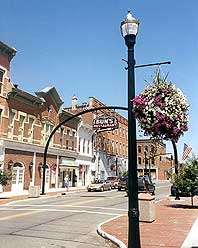
Economy
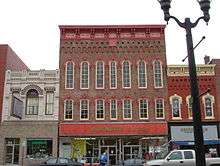
There is a true economic mix in the area. The economic mix of the country reveals a balance of the following main economic activities: Manufacturing(18%), Trade (27%), Government (15%), and Service (23%) according to statistics published by Delaware Area Chamber of Commerce in 2000. The largest employers are in automobile coatings, plastics, copper products, education, insurance, automobile parts and distribution, sports apparel, retail, services, and government. Delaware County is a net importer of workers from throughout Ohio.
Law and government
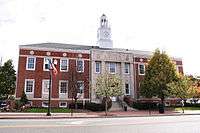
All legislative powers are vested in the City Council. The Council consists of seven members: four of them are elected on a non-partisan basis in four wards and three are elected at large. They are elected for four-year terms. The Council elects a mayor among its three at-large members who serves for a term of two years. The mayor preserves his right to be able to vote in the Council. A Vice Mayor is also chosen in the same manner, also for a two-year term.
The city manager handles the day-to-day administration of the City. The City Manager is appointed by the City Council. The current City Manager is R.Thomas Homan.
Current City Council Members
- Carolyn Kay Riggle, Mayor
- George Hellinger, Vice-Mayor
- Kent Shafer, At Large
- Christopher Jones, First Ward
- Lisa Keller, Second Ward
- Joe Di Genova, Third Ward
- Andrew Brush, Fourth Ward
Mayors
- 1954 to 1956 Paul Bale White
- 1956 to 1957 Edward Flahive
- 1958 to 1959 Paul B. White
- 1959 to 1961 Henry Wolf
- 1961 to 1963 Paul B. White
- 1963 to 1965 Donald Mathews
- 1965 to 1969 Robert Ray Newhouse
- 1969 to 1971 Gilford E. Easterday
- 1971 to 1973 John Jeisel III
- 1973 to 1977 Gilford E. Easterday
- 1978 to 1981 Donald Wuertz
- 1982 to 1983 Donald Worly
- 1984 to 1985 Michael Shade
- 1986 to 1989 Donald Wuertz
- 1990 to 1993 Michael Shade
- 1994 to 1995 Dennis Davis
- 1996 to 1999 Juliann Secrest
- 2000 to 2002 Tommy W. Thompson
- 2002 to 2009 Windell Wheeler
- 2009 to 2014 Gary Milner
- 2014 to Present Carolyn Kay Riggle
Schools
Ohio Wesleyan University
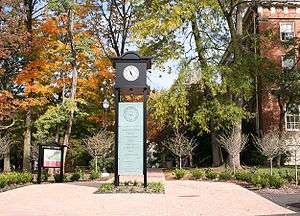
Ohio Wesleyan is a private independent liberal arts college located in the heart of Delaware. Ohio Wesleyan University enrolls approximately 1,950 students from 40 states and more than 50 countries. The level of academic excellence has placed Wesleyan among the 80 top liberal arts colleges in the annual rankings published by the US News and World Report. According to the same magazine, the university was recognized as one of the Best College Values among the top 40 in the United States. Students live in residence halls and benefit from a large campus providing academics, athletics and services. There is a traditionally positive town-government relationship, with Wesleyan student volunteers in the Delaware community and coordination of institutional and cultural interests with the City. Due to high enrollment of minority and international students at the University, it has influenced the international, ethnic and religious diversity of Delaware.
The Methodist Theological School in Ohio
The Methodist Theological School in Ohio is a graduate school seminary located between Delaware and Columbus, Ohio. Often referred to as Methesco.
Delaware Joint Vocational School District
Delaware City School District
The Delaware City School District, which encompasses Delaware and the surrounding area, enrolls about 5500 K-12 students.
High schools
Middle school
- John C. Dempsey Middle School
- Willis Intermediate School
Elementary schools
- Ervin Carlisle Elementary
- James A. Conger Elementary
- Robert F. Schultz Elementary
- David Smith Elementary
- Laura Woodward Elementary
Private schools, K-12
- Delaware Christian School
- Grace Community School
- St. Mary School
Sister city
A sister city partnership was signed May 13, 2011, by the Cities of Delaware and Baumholder, Germany, highlighting a four-day stay in Delaware by a Baumholder delegation, in which the guests established relationships with local government, business and educational leaders. The four-person delegation was led by Baumholder Mayor Peter Lang, who was joined by Deputy Mayors Michael Röhrig and Christian Flohr; and Council Member Ingrid Schwerdtner. Mayor Lang and Delaware Mayor Gary Milner, with their respective elected delegations looking on, signed a joint resolution, “holding the firm belief that this agreement will contribute toward the peace and prosperity of the world, and do hereby pledge to cooperate with each other as twin/sister cities.”
Baumholder and Delaware have had a relationship for more than 20 years, thanks to the Ohio Wesleyan University men’s soccer team. Every three years since the early 1990s, the team travels to Baumholder for a series of summer friendships games. Additionally, Baumholder is home to a 12,000-personnel U.S. Army garrison. With the partnership in place, the two cities now will focus on creating an educational and interactive environment for networking, sharing best practices and engaging elected officials.
Notable people
- Horace Newton Allen, U.S. diplomat
- Alexander Borteh, professional poker player
- Tyler Christopher, actor on General Hospital
- Cliff Curtis, baseball player
- Amos Dolbear, American physicist and inventor
- Francis Thomas Evans, Sr., pioneer aviator
- Charles W. Fairbanks, the 26th Vice President of the United States
- Robert Flanagan, novelist
- Arthur Flemming, former United States Secretary of Health, Education, and Welfare
- Lloyd Gardner, diplomatic historian
- Lucy Webb Hayes, First Lady
- Rutherford B. Hayes, the 19th President of the United States (1877–1881)[21]
- Todd M. Hughes, Circuit Judge, U.S. Court of Appeals for the Federal Circuit
- Vincente Minnelli, motion picture director
- Branch Rickey, Major League Baseball executive
- Buck Rodgers, professional baseball player
- Frank Sherwood Rowland, a chemistry Nobel laureate
- Rick Scarry, actor
- Ezra Vogel, professor
References
- 1 2 "US Gazetteer files 2010". United States Census Bureau. Retrieved 2013-01-06.
- 1 2 "American FactFinder". United States Census Bureau. Retrieved 2013-01-06.
- ↑ "Population Estimates". United States Census Bureau. Retrieved 2013-06-17.
- ↑ "Find a County". National Association of Counties. Retrieved 2011-06-07.
- ↑ "Annual Estimates of the Population of Combined Statistical Areas: April 1, 2000 to July 1, 2008". U.S. Census Bureau. Retrieved 2009-08-02.
- ↑ "Profile for Delaware, Ohio, OH". ePodunk. Retrieved 2012-07-15.
- ↑ O.L. Baskin & Co (1880). History of Delaware County and Ohio. Chicago: O.L. Baskin & Co. pp. 193–194.
- ↑ O.L. Baskin & Co (1880). History of Delaware County and Ohio. Chicago: O.L. Baskin & Co. p. 322.
- ↑ O.L. Baskin & Co (1880). History of Delaware County and Ohio. Chicago: O.L. Baskin & Co. p. 324.
- ↑ Fischer, Jr., William. "Camp Delaware Marker". The Historical Marker Database. Retrieved 18 August 2011.
- ↑ "US Gazetteer files: 2010, 2000, and 1990". United States Census Bureau. 2011-02-12. Retrieved 2011-04-23.
- ↑ "Annual Estimates of the Resident Population for Incorporated Places: April 1, 2010 to July 1, 2015". Retrieved July 2, 2016.
- ↑ "Number of Inhabitants: Ohio" (PDF). 18th Census of the United States. U.S. Census Bureau. Retrieved 22 November 2013.
- ↑ "Ohio: Population and Housing Unit Counts" (PDF). U.S. Census Bureau. Retrieved 22 November 2013.
- 1 2 "American FactFinder". United States Census Bureau. Retrieved 2008-01-31.
- ↑ "Incorporated Places and Minor Civil Divisions Datasets: Subcounty Population Estimates: April 1, 2010 to July 1, 2012". U.S. Census Bureau. Retrieved 25 November 2013.
- ↑ "Delaware Ohio, Community". Archived from the original on September 10, 2007. Retrieved 2007-09-12.
- ↑ Northwest Neighborhood Association Website
- ↑ "gallery". www.delawarenna.org. Retrieved 2015-12-06.
- ↑ "ThisWeek Community Newspapers". Retrieved 2007-09-12.
- ↑ Overman, William Daniel (1958). Ohio Town Names. Akron, OH: Atlantic Press. p. 37.
External links
| Wikimedia Commons has media related to Delaware, Ohio. |
| Wikivoyage has a travel guide for Delaware, Ohio. |
- Official site of the City of Delaware.
- Codified Ordinances of The City of Delaware Ohio (Note: To expand the page's Contents, click on the yellow-folder icon.)
- Delaware County Memory - Digital archive of historical documents and artifacts from Delaware County
 Texts on Wikisource:
Texts on Wikisource:
- "Delaware, a city and county-seat of Delaware co., O.". Collier's New Encyclopedia. 1921.
- "Delaware, Ohio". The New Student's Reference Work. 1914.
- "Delaware, a city and the county-seat of Delaware county, Ohio, U.S.A.". Encyclopædia Britannica (11th ed.). 1911.
- "Delaware. A city and the county-seat of Delaware County, Ohio". New International Encyclopedia. 1905.
- "Delaware, or Delaware Court House, a town and the capital of Delaware co., Ohio". The American Cyclopædia. 1879.
- "Delaware, a city of the United States". Encyclopædia Britannica. 7 (9th ed.). 1878.
